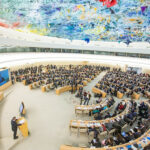The European Commission developed the Sustainable Finance Disclosure Regulation (SFRD) to resolutely gear investments towards sustainable investing. In an effort to curb greenwashing, the directive aims for greater fund comparability and transparency against 3 sustainability factors:
- Sustainability risks, defined causing a material negative impact on investment value. Think climate change, related extreme weather events or water stewardship imperatives.
- PASI – Primary Adverse Sustainability Impacts as negative, material, or potentially material effects on sustainability factors that result from, worsen, or are directly related to investment choices or advice performed by a legal entity. Think of an organization’s carbon footprint.
- Pre-contractual and periodic sustainable investment disclosures for Article 8 and Article 9 investment products. The latter are required to assess their portfolio against the principle of “do no significant harm” by considering the Principal Adverse Sustainability Impacts and incorporating considerations of the minimum safeguards – per the Taxonomy Regulation (2020/852).
The issue with this notion of doing No Significant Harm lies in extending these requirements to ensuring Article 8 and 9 funds enforce and promote Human Rights across their portfolio.
1. Differentiating SFRD Article 8 And Article 9 Funds
The European directive targets all EU-based financial market participants and financial advisors, including those based outside of the bloc but selling products to clients in the European Union. They will now be called upon to classify ESG funds and other investment products into 3 distinct categories, each with their specific set of requirements.
To start with, asset managers must now categorize their funds as non-sustainable – for example if they include stocks in high-risk sectors such as tobacco or thermal coal. These so-called Article 6 funds do not embed sustainability issues in their decision-making. At all. Explicitly so. Of particular concern, however, are Article 8 and 9 funds which are expected, at least nominally, to uphold sustainable action.
- Article 8 Funds Characteristics
Article 8 funds are often referred to as light green, given these financial products are intended to promote environmental and/or social characteristics as part of a sound corporate governance. Conversely, a fund’s consideration of the 14 principal adverse sustainability impacts listed in the draft regulatory technical standards does not automatically qualify it as an Article 8 Fund. They must imperatively embed the relevant indicators in their decision processes. Morningstar in particular describes Article 8 funds as a catch-all category with a fairly conservative approach to ESG-based exclusions.
- Article 9 Funds Added Requirements
Article 9, on the other hand, are referred to as dark green, owing to the fact these products are built either around a sustainable investment goal or a carbon emissions reduction. The entirety of the portfolio must therefore qualify as sustainable investments aligned with the Do No Significant Harm principle. Building on Article 8 requirements, Article 9 fund managers are required to double down on their risk assessment against the social safeguards specified in the Taxonomy Regulation. Per the draft regulatory technical standards, Article 9 Funds with a carbon reduction goal must refer to an EU Climate Transition Benchmark or EU Paris-aligned Benchmark.
2. Greenwashing Concerns and Lack of SFRD Guidance
According to Morningstar, funds classified under Article 8 – in other words, with environmental or social characteristics – account for 30.3% of European fund assets. Conversely, 3.7% of assets are invested in SFDR Article 9 funds, which pursue sustainability as a core investment objective.
Meanwhile, investment in SFDR Article 8 and Article 9 funds reached €4.18 trillion in the first quarter of 2022 – representing upwards of 42.4% of all funds sold in the European Union… and counting.
- Greenwashing Concerns
These glowing statistics come at a price. As it stands, 27% of Article 9 funds were surprisingly exposed to firms deriving more than 5% of revenues from thermal coal for at 1%. Comparatively, that figure dropped to 19% for Article 8 funds, versus 22% of non-classified funds. Similarly, 33% of article 8 are subject to more than a 5% exposure to fossil fuel operators (compared to 30% of Article 9 funds and 38% of non-classified funds. It follows that fund managers can fully comply with the SFRD while including companies that operate in both the renewable and thermal coal sector. The same goes for working for oil major provided they have carbon reduction targets.
This issue of ambiguous language in nothing new and not specific to SFRD compliance alone. A Qontigo report analyzed 12 European sustainable labels concluding it is practically impossible to design an investment product aligned with all key labels. The goal of the SFRD, however, was to develop a certain degree of normative quality for end-investors – in other words, pushing fund managers to adjust their offering to curb the misallocation of funds and greenwashing.
With that in mind, the European Securities and Markets Authority is slated to provide a definition of greenwashing as part of its responsibility to enforce the European sustainable finance roadmap. This is not only a European issue, either. With the backing of the U.S. Securities and Exchange Commission, researchers analyzed how natural language processing could help determine how funds with “ESG” in their name define ESG in the first place.
- Lagging Policy Guidance
The rather unexpected market enthusiasm for Article 8 and Article 9 funds signals vastly different interpretations of the SFRD rather than solid sustainability preferences or investment goals.
A key culprit is the delay in publishing Level 2 Regulatory Technical Standards – and with it, the development of Article 8 and Article 9 fund disclosure templates. The hope is the new document will specify clear metrics for funds to demonstrate how they designed their overarching goals – and, perhaps more importantly, how they intend to deliver.
In the meantime, unclear policy guidance allowed distributors and fund buyers to pressure managers in labelling their funds as Article 8 or Article 9 funds without doing the work. Morningstar itself had to remove more than 1,200 funds with a combined $1.4 trillion in assets from its European sustainable investment list after an “extensive review” of their legal filings – most of which boasted as Article 8 funds. Indeed, some of the largest Article 8 fund – or particular concern – have not even found it necessary to market themselves as particularly green.
3. Embedding Human Rights in Article 8 and 9 Funds
We have described how funds qualify as sustainable and aligned with the EU Taxonomy provided their activities make a substantial contribution to 1 of 5 environmental or social objectives, that they Do No Significant Harm and comply with minimum safeguards. Here’s how Ksapa operates with its financial services clients to ensure compliance articulating PASI and Impact managing funds.
- Articulating the SFRD and Human Rights Responsibilities
The latter are defined in article 18 of the SFRD per the OECD Guidelines for Multinational Enterprises and the UN Guiding Principles on Business and Human Rights. More specifically, these safeguards are harmonized with the 8 core conventions of the International Labor Organization and the International Bill of Human Rights.
In addition, the vision behind the Do No Significant Harm principle is that investors move to perform against a core environmental or social indicator while meeting a minimum baseline standard across all others. That said, because of the green bent of the EU Taxonomy, investments typically focus on carbon emissions target and metrics – often at the expense of other key environmental data (e.g. water, waste and biodiversity stewardship).
Given the Social Taxonomy is still under development, social objectives, while clearly included in article 2(17) of the SFRD, run the risk of being overlooked entirely. It remains Article 8 and 9 funds manager must acknowledge their responsibility to enforce and promote Labor and Human Rights. In other words, avoid potential violations and address the related adverse impacts they may cause, contribute to or be linked throughout their investment universe.
- Embedding Human Rights in Article 8 and 9 disclosures
Recognizing relevant data may not be available, the Regulatory Technical Standards recommend a controversy screening – to determine SFRD compliance. In other words, companies should be screened prior to inclusion in Article 8 or 9 funds, to identify any involvement in controversial conduct related to the Do No Significant Harm objectives or minimum safeguards. We at Ksapa would however argue that, done right, comprehensive Human Rights due diligence allows investors to identify and prevent potentially adverse risks before they even occur and address or mitigate readily-identified impacts.
Here is Ksapa’s 3-step approach for Article 8 and 9 fund managers, not to just to curb risk occurrence, but to proactively mitigate and ultimately prevent Human Rights violations.
Step 1 : Prioritize Relevant Human Rights Risks
This first step could be boiled down to the recognition Article 8 and 9 fund managers cannot manage everything – least of which complex and highly sensitive issues such as Human Rights across their portfolio. It is therefore all the more imperative that they start with what they know and build up capacity as part of a continuous improvement process. Here are 3 core dimensions to bear in mind:
- Industry: A sound starting point lies in identifying investee companies’ sector-specific Human Rights risks. Think of the importance of private data (gender, salary, patrimony, saving habits…) for the financial sector. This digital rights issues is not nearly as prevalent in the agriculture sector. On the other hand, cultivating food crops, for example, warrants particular emphasis on labor rights.
- Country: Another factor to bear in mind is the local context. Indeed, investing in a country subject to weak governance implies additional risk exposure compared, say, to an OECD State. Indeed, informal work is particularly prevalent in Latin America warranting greater scrutiny of investee’s compliance with labor rights.
- People: Similarly, Human Rights concerns do not materialize evenly for rightsholders, which typically include workers, contracted, third-party and supply chain workers, users and local communities. Fund managers must indeed consider how investee operations may impact them to a varying degree, acknowledging these rightsholder segment include vulnerable people (women, youths, disabled, elderly or indigenous people, notably) which may be disproportionately negatively impacted.
Step 2: Assess Human Rights Mitigation Process Maturity
As a result of Step 1, fund managers are expected to better understand whether potential Human Rights issues are indeed relevant and already mitigated by their investee. If not, they may assess risk severity and scale to select the most material Human Rights issues. Here is how they may develop due diligences on any residual adverse impacts and develop the corresponding progress monitoring plans:
- Go/No-Go Decision: The management of actual and potential negative Human Rights outcomes should be reflected in the investment decision-making process – in the selection, appointment and monitoring of external managers and funds and other services providers. Prior to deciding to invest, fund managers should assess the negative Human Rights outcomes of potential investees and set clear expectations indexed on the UNGP – including in relations to third-party investment managers. Following a Go decision, fund managers should track actual and potential negative Human Rights outcomes tied to their investments, using and building influence to ensure that investees address them – which measures monitoring and reporting on progress.
- Investee Stewardship: Article 8 and 9 funds have a unique ability and responsibility to exert their influence, if only to secure SFRD compliance. In any case, through their engagement and voting powers, they are in a prime position to influence investee activities, to prevent and mitigate negative Human Rights outcomes and enable access to remedy when an actual negative outcome occurs. Managers may likewise exert influence by engaging with local public and private stakeholders, so that operating environments fully uphold Human Rights.
- Maturity Assessments: Article 8 and 9 fund manager must assess their processes in terms of their ability to identify, remedy and prevent Human Rights violations. Available tools may not cover all salient issues. They may not exist at all. Wherever due diligences uncover blind spots, they must develop the necessary mitigative apparatus. This may take the form of a policy, sectoral or country-specific toolboxes or decision trees.
Step 3: Empower Teams to Address Human Rights
Fund managers may not necessarily understand their Human Rights responsibilities first hand. Their teams may be particularly wary of engaging on such sensitive issues. All sourcing, investment and monitoring teams are however key to enabling fund management to make informed decisions. With that in mind, here are a few tips to build out teams’ capacity to address Human Rights:
- Develop cohesive systems: Statements. Policies. Taxonomies. Engagement activities. All these tools must pursue a single, cohesive goal and convince stakeholders Article 8 and 9 funds include Human Rights in their decision-making and across their operations.
- Identify champions: One way to develop a cohesive Human Rights strategy is to identify internal ambassadors. This indeed creates an network of champions able to onboard peers much more dynamically than through top-down corporate due diligence assignments.
- Keep it simple: Real-world examples and case studies help teams identify situations they have encountered and may deal with again. Capacity-building programs typically include some level of roleplay, to encourage staff to step into the shoes of specific rightsholders.
Conclusion
Designed to foster sustainable investment, the Sustainable Finance Disclosure Regulation generated major market enthusiasm for Article 8 and Article 9 funds. As they stand, however, these new financial products are subject to major greenwashing concerns. Indeed, we argue robust Article 8 and 9 funds should fully embed Human Rights: despite incomplete guidance, tools are readily available for funds managers to demonstrate they in actuality Do No Significant Harm and comply with minimum safeguards.
The issue, of course, is that Human Rights are not the sole responsibility of a single fund, be it an Article 8 or 9 fund, but that of multiple duty-bearers. It is therefore key that fund managers acknowledge their specific Human Rights risks, assess the process they put in place and build their teams’ relevant capacities. In short, where are their salient Human Rights risks? Do investee companies have a realistic action plan to avert these risks? How should investee companies and fund managers work together to effectively progress on these issues?
As the European Union – and with it other countries operating within the bloc – reinforces SFRD requirements and disclosure templates, Article 8 and 9 funds will have nurture greater trust in their approaches and the underpinning process to secure long-term resilience. Human Rights action help them achieve just that – and weave further predictability in the investment landscape in the process.
Ksapa stands at the ready to share expertise and support you in adapting to environmental and social pressures, drive real impact throughout your organization right from very start. That said, should your unique circumstances require more thorough attention, we are also prepared to involve our advisory and investing teams to offer guidance toward the resilience, inclusiveness and competitiveness of your business or investments.
As a sustainability and corporate responsibility consultant, Margaux joined Ksapa with international experience in public, private and non-profit organizations. She had previously worked for the Deloitte and Quantis sustainability consultancies, lobbied for environmental research on behalf of the INRA and contributed to Total’s extra-financial reporting.
A Franco-American citizen, Margaux holds sustainability certifications from the IEMA and Centrale-Supélec on top of a Masters degree in History, Communications, Business and Internal Affairs.
She is fluent in French, English and Spanish.






